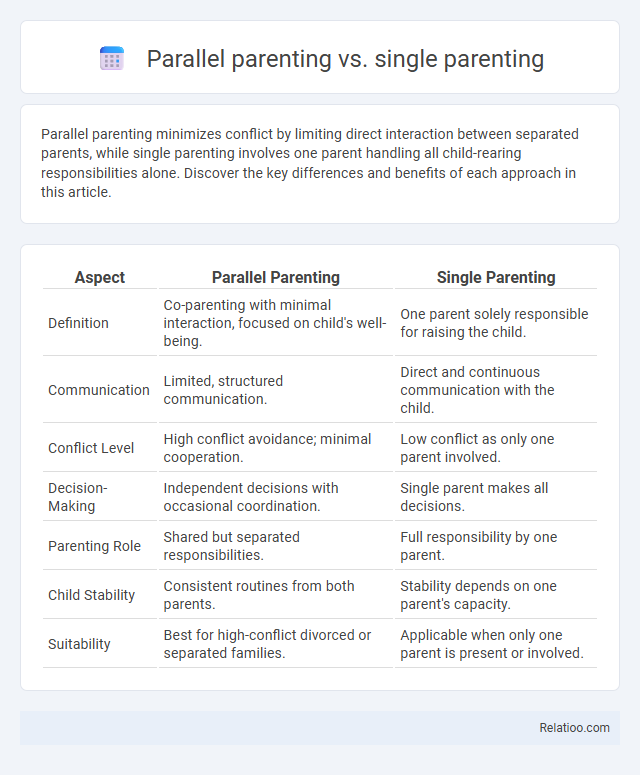Parallel parenting minimizes conflict by limiting direct interaction between separated parents, while single parenting involves one parent handling all child-rearing responsibilities alone. Discover the key differences and benefits of each approach in this article.
Table of Comparison
| Aspect | Parallel Parenting | Single Parenting |
|---|---|---|
| Definition | Co-parenting with minimal interaction, focused on child's well-being. | One parent solely responsible for raising the child. |
| Communication | Limited, structured communication. | Direct and continuous communication with the child. |
| Conflict Level | High conflict avoidance; minimal cooperation. | Low conflict as only one parent involved. |
| Decision-Making | Independent decisions with occasional coordination. | Single parent makes all decisions. |
| Parenting Role | Shared but separated responsibilities. | Full responsibility by one parent. |
| Child Stability | Consistent routines from both parents. | Stability depends on one parent's capacity. |
| Suitability | Best for high-conflict divorced or separated families. | Applicable when only one parent is present or involved. |
Understanding Parallel Parenting: Definition and Key Concepts
Parallel parenting is a co-parenting arrangement where parents minimize direct interaction to reduce conflict, focusing instead on communication through written or digital means. Unlike single parenting, where one parent assumes full responsibility, parallel parenting divides parenting duties while maintaining clear boundaries and separate schedules. Understanding your role in parallel parenting helps create a stable environment for your child by prioritizing consistent rules and minimizing parental disputes.
Defining Single Parenting: Structure and Challenges
Single parenting involves one caregiver solely responsible for the child's upbringing, managing daily routines, education, and emotional support without a co-parent's consistent involvement. This structure often presents challenges such as balancing work and childcare, financial constraints, and limited social support, impacting both parent and child well-being. Unlike parallel parenting, which separates co-parenting duties to minimize conflict, single parenting requires comprehensive management of all parental roles independently.
Core Differences Between Parallel and Single Parenting
Parallel parenting involves minimal direct interaction between parents, who independently manage their child's upbringing post-separation, minimizing conflict and communication. Single parenting means one parent assumes full responsibility for parenting duties without the involvement or cooperation of the other parent. The core difference lies in the level of parental collaboration: parallel parenting limits communication to reduce conflict, while single parenting centralizes decision-making and caregiving in one individual.
Benefits of Parallel Parenting for Families in Conflict
Parallel parenting minimizes direct contact between parents in high-conflict situations, reducing emotional stress and promoting stability for children. This approach allows you to establish clear boundaries and structured communication, fostering a more peaceful environment compared to single parenting, where one parent assumes sole responsibility. Benefits include consistent routines and decreased exposure to parental conflict, which supports children's emotional well-being and overall family harmony.
Unique Advantages of Single Parenting
Single parenting offers unique advantages such as complete autonomy in decision-making and the ability to establish consistent routines without requiring coordination with another caregiver. This independence can foster a strong, singular focus on the child's emotional and developmental needs. Unlike parallel parenting, single parents have the flexibility to adapt parenting styles quickly and create a cohesive household environment.
Common Challenges Faced in Parallel Parenting
Common challenges faced in parallel parenting include difficulty maintaining consistent communication between parents, managing conflicts without direct interaction, and ensuring that both parents adhere to agreed-upon schedules and rules. Your ability to establish clear boundaries and cooperation is crucial to minimize misunderstandings and provide a stable environment for the child. Unlike single parenting, where one parent handles decision-making, parallel parenting requires disciplined coordination despite limited contact.
Key Obstacles in Single Parenting Dynamics
Single parenting often faces key obstacles such as financial strain, emotional burnout, and limited social support, which can impact your ability to provide consistent care and stability. Parallel parenting mitigates conflict by minimizing direct communication between co-parents, promoting individual responsibility for children. In contrast, cooperative parenting requires active collaboration, which can be challenging when trust or communication is weak.
Emotional Impact on Children: Parallel vs Single Parenting
Parallel parenting minimizes direct conflict between separated parents, reducing children's exposure to emotional stress and anxiety compared to high-conflict single parenting situations. Children experience greater emotional stability as parallel parenting boundaries limit parental disputes, fostering a more predictable and secure environment. Single parenting may intensify emotional challenges for children due to increased parental responsibilities and potential financial strain, impacting their overall well-being.
Strategies for Success in Both Parenting Approaches
Parallel parenting strategies for success include clearly defined boundaries and minimal direct communication to reduce conflict, while single parenting thrives on consistent routines and strong support networks. Both approaches benefit from effective time management, emotional regulation, and prioritizing the child's well-being to foster stability. Utilizing co-parenting apps and professional mediation can enhance cooperation and decision-making in parallel parenting scenarios.
Choosing the Right Parenting Style: Factors to Consider
Choosing the right parenting style depends on factors such as co-parenting dynamics, communication levels, and the child's emotional needs. Parallel parenting works best when parents have high conflict but can maintain separate roles, while single parenting requires managing all responsibilities independently. Your ability to foster stability, consistency, and emotional support will guide the decision between parallel parenting, single parenting, or other co-parenting methods.

Infographic: Parallel parenting vs Single parenting
 relatioo.com
relatioo.com